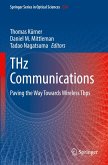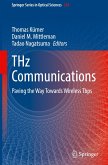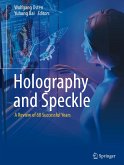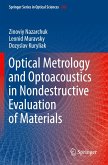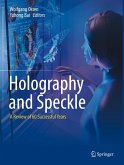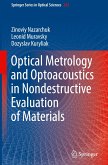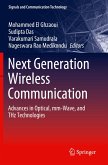Metrology for THz Communications
Findings from DFG FOR 2863 Meteracom
Herausgegeben:Kürner, Thomas; Doeker, Tobias; Humphreys, David; Kleine-Ostmann, Thomas; Schneider, Thomas
Metrology for THz Communications
Findings from DFG FOR 2863 Meteracom
Herausgegeben:Kürner, Thomas; Doeker, Tobias; Humphreys, David; Kleine-Ostmann, Thomas; Schneider, Thomas
- Gebundenes Buch
- Merkliste
- Auf die Merkliste
- Bewerten Bewerten
- Teilen
- Produkt teilen
- Produkterinnerung
- Produkterinnerung
This book provides a state-of-the-art overview of metrology for upcoming THz communications, considered a key component of next generation wireless communication systems. Effective methods to conduct and evaluate measurements are crucial for the advancement of THz communication systems. However, at the start of the project in 2019, metrology at THz frequencies was still in its infancy, and thus far had only addressed detector calibration to characterize ultrafast devices as well as measuring uncertainty analyses of different spectrometer types available at THz frequencies. This book highlights…mehr
Andere Kunden interessierten sich auch für
![THz Communications THz Communications]() THz Communications65,99 €
THz Communications65,99 €![THz Communications THz Communications]() THz Communications106,99 €
THz Communications106,99 €![Holography and Speckle Holography and Speckle]() Holography and Speckle136,99 €
Holography and Speckle136,99 €![Optical Metrology and Optoacoustics in Nondestructive Evaluation of Materials Optical Metrology and Optoacoustics in Nondestructive Evaluation of Materials]() Zinoviy NazarchukOptical Metrology and Optoacoustics in Nondestructive Evaluation of Materials113,99 €
Zinoviy NazarchukOptical Metrology and Optoacoustics in Nondestructive Evaluation of Materials113,99 €![Holography and Speckle Holography and Speckle]() Holography and Speckle137,99 €
Holography and Speckle137,99 €![Optical Metrology and Optoacoustics in Nondestructive Evaluation of Materials Optical Metrology and Optoacoustics in Nondestructive Evaluation of Materials]() Zinoviy NazarchukOptical Metrology and Optoacoustics in Nondestructive Evaluation of Materials113,99 €
Zinoviy NazarchukOptical Metrology and Optoacoustics in Nondestructive Evaluation of Materials113,99 €![Next Generation Wireless Communication Next Generation Wireless Communication]() Next Generation Wireless Communication100,99 €
Next Generation Wireless Communication100,99 €-
-
-
This book provides a state-of-the-art overview of metrology for upcoming THz communications, considered a key component of next generation wireless communication systems. Effective methods to conduct and evaluate measurements are crucial for the advancement of THz communication systems. However, at the start of the project in 2019, metrology at THz frequencies was still in its infancy, and thus far had only addressed detector calibration to characterize ultrafast devices as well as measuring uncertainty analyses of different spectrometer types available at THz frequencies.
This book highlights how the grand challenge of metrology in THz communication measurements was addressed systematically in the publicly funded project DFG FOR 2863 Meteracom (Metrology for Terahertz Communications). It delves into four distinct and foundational project areas: traceability to the International System of Units (SI), characterization of the measurement system itself, metrological characterization of the RF components and the propagation channel, and measurements required for enabling the functionality of THz communications. This is an open access book.
This book highlights how the grand challenge of metrology in THz communication measurements was addressed systematically in the publicly funded project DFG FOR 2863 Meteracom (Metrology for Terahertz Communications). It delves into four distinct and foundational project areas: traceability to the International System of Units (SI), characterization of the measurement system itself, metrological characterization of the RF components and the propagation channel, and measurements required for enabling the functionality of THz communications. This is an open access book.
Produktdetails
- Produktdetails
- Springer Series in Optical Sciences 256
- Verlag: Springer / Springer Nature Switzerland / Springer, Berlin / Technische Universität Braunschweig
- Artikelnr. des Verlages: 89269770, 978-3-032-01985-1
- Seitenzahl: 658
- Erscheinungstermin: 26. Februar 2026
- Englisch
- Abmessung: 235mm x 155mm
- ISBN-13: 9783032019851
- ISBN-10: 3032019850
- Artikelnr.: 74854043
- Herstellerkennzeichnung
- Springer-Verlag GmbH
- Tiergartenstr. 17
- 69121 Heidelberg
- ProductSafety@springernature.com
- Springer Series in Optical Sciences 256
- Verlag: Springer / Springer Nature Switzerland / Springer, Berlin / Technische Universität Braunschweig
- Artikelnr. des Verlages: 89269770, 978-3-032-01985-1
- Seitenzahl: 658
- Erscheinungstermin: 26. Februar 2026
- Englisch
- Abmessung: 235mm x 155mm
- ISBN-13: 9783032019851
- ISBN-10: 3032019850
- Artikelnr.: 74854043
- Herstellerkennzeichnung
- Springer-Verlag GmbH
- Tiergartenstr. 17
- 69121 Heidelberg
- ProductSafety@springernature.com
Thomas Kürner (Fellow IEEE) received his Dipl.-Ing. degree in Electrical Engineering in 1990, and his Dr.-Ing. degree in 1993, both from University of Karlsruhe (Germany). From 1990 to 1994 he was with the Institut für Höchstfrequenztechnik und Elektronik (IHE) at the University of Karlsruhe. From 1994 to 2003, he was with the radio network planning department at the headquarters of the GSM 1800 and UMTS operator E-Plus Mobilfunk GmbH & Co KG, Düsseldorf. Since 2003 he is Full University Professor for Mobile Radio Systems at the Technische Universität Braunschweig. Currently he is chairing the IEEE 802.15 Standing Committee THz and the ETSI Industrial Specification Group THz. He has been Spokesman of the German DFG-Research Unit FOR 2863 Meteracom (“Metrology for THz Communications”). He is one of the editors of the Springer book on "THz Communications". He has also authored or co-authored numerous book chapters. Tobias Doeker received his Bachelor of Science (B.Sc.) degree in Electrical Engineering from Hamburg University of Applied Science in 2017 and his Master of Science (M.Sc.) degree in Electrical Engineering from Technische Universität Braunschweig in 2019. Besides, from 2013 to 2019 he was a student trainee at Lufthansa Technik AG in Hamburg. In November 2019 he joined the Institute for Communications Technology at Technische Universität Braunschweig as a researcher where he is currently working towards his Ph.D. degree. His research interests are focused on the THz communication and here especially on radio channel measurements and characterization as well as device discovery for Multi Gigabit Indoor Communication at 300 GHz. With his work he is involved in an edited book on THz communications and has contributed here as an author. David A. Humphreys (CEng, Fellow IET, Life Senior Member IEEE) received a PhD in Electronic Engineering (1990, London University, UK). At the National Physical Laboratory, UK (1978 to 2022) he developed metrology for photodiodes at up to mm-wave frequencies, optical wavelength capabilities for optical communications instrumentation and waveform metrology for RF communications, including several Euramet projects and international collaborations. Standards activities: Vice-Chair of pre-standards group for IEEE 1765 “The uncertainties in Error-Vector-Measurement (EVM)”. Contributions to pre-standard work on IEC Point-by-point uncertainties (TC85, WG 22) and various IEC TC86 WG4 on standards for optical fibre measurement. He was awarded the IEE Ambrose Fleming Premium in 1987 and is currently a Mercator Fellow (Meteracom), a Visiting Industrial Research Fellow (University of Bristol, UK) and a Guest worker (PTB, Germany). Thomas Kleine-Ostmann studied electrical engineering at the TU Braunschweig and at Virginia Polytechnic Institute and State University. After receiving his M. Sc. degree in 1999 and his Dipl.-Ing. degree in 2001, he received his Dr.-Ing. degree in 2005. In 2003, he was awarded the Kaiser Friedrich Research Prize for his work on imaging with continuous THz radiation. Since 2006, he has been a scientist at the Physikalisch-Technische Bundesanstalt (PTB) in Braunschweig. Since then, he has been involved in the representation and dissemination of the unit of electric field strength, electromagnetic compatibility, the further development of antenna metrology, and submillimeter wave metrology. At the TU Braunschweig, he teaches High Frequency and Mobile Communications Metrology and habilitated in the field of high frequency technology. Since 2020, he has been head of the High Frequency and Fields Department at PTB. He contributed to the Springer book on "THz Communications" and to other book publications. Thomas Schneider is the head of the THz-photonics group at the Technische Universität Braunschweig, Germany. He received the diploma degree in electrical engineering from the Humboldt Universität zu Berlin, Germany, in 1995, and the Ph.D. degree in physics from the Brandenburgische Technische Universität Cottbus, Germany in 2000. From 2000 to 2014 he was with the Hochschule für Telekommunikation (HfT) in Leipzig, Germany. From 2006 to 2014 he was the head of the Institut für Hochfrequenztechnik at the HfT. Dr. Schneider was a guest professor at the Swiss Federal Institute of Technology (EPFL), Lausanne, Switzerland, a guest scientist at the Deutsche Telekom Innovation Laboratories and the Fraunhofer Heinrich Hertz Institute Berlin. His current research interests include Terahertz metrology, integrated and microwave photonics, photon-phonon coupling in nano-waveguides and high-bandwidth signal processing with low-bandwidth electronics.
Chapter 1. Introduction.- Chapter 2. Metrology Definition, Use Cases, Added Value.- Chapter 3. RF Power Metrology.- Chapter 4. Phase Noise Metrology.- Chapter 5. Waveform Metrology.- Chapter 6. Vector Network Analysis.- Chapter 7. Terahertz Time-Domain Spectroscopy.- Chapter 8. Channel Sounding.- Chapter 9. Photonics Assisted Signal Processing.- Chapter 10. Ray Tracing for Metrology.- Chapter 11. Hardware Acceleration.- Chapter 12. Waveform Traceability Chain to coaxial EOS.- Chapter 13. Characterising VNA Measurements of Time-Varying Sub-Terahertz Transmissions.- Chapter 14. THz Waveform Traceability.- Chapter 15. Constellation Diagrams, EVM, and Error Correction.- Chapter 16. Architecture for Channel Sounding.- Chapter 17. Multidimensional Parameter Estimation for Channel Sounding.- Chapter 18. Variable Reference Structure for THz Channel Sounding.- Chapter 19. Artefacts for Channel Sounding Performance Evaluation.- Chapter 20. Integrated Photonics Assisted Signal Processing and Thermal Crosstalk.- Chapter 21. Error Metrics for Photonics Assisted Signal Processing.- Chapter 22. Photonics Assisted Signal Processing Systems using Parallelisation in Time and Frequency Domain.- Chapter 23. Metrological Analysis of Non-idealities for Photonics Assisted Signal Processing.- Chapter 24. Metrology of mmW- and THz-Frequency- and Time-DomainWaveforms.- Chapter 25. Behavioural Characterization of Nonlinear Distortion.- Chapter 26. Electronic Signal Generation.- Chapter 27. Electronic Signal Conversion, Signal Amplification and Distortion Mechanisms.- Chapter 28. Frequency Synthesis based on MLLs.- Chapter 29. Integrated Photonically Assisted Samplers.- Chapter 30. Atmospheric Aspects.- Chapter 31. Building Materials.- Chapter 32. Interaction of Objects with THz Beams.- Chapter 33. Multipath Propagation in Rich Scattering.- Chapter 34. Time-variant Propagation Channel including Metrics and Multi-link Connection. Chapter 35. Physical Layer Security. Chapter 36. Simulation and Modelling of Electronic and Photonic Components.- Chapter 37. Link- and System-Level Simulation Towards Digital Twinning.- Chapter 38. Trustworthy Modulation Recognition.- Chapter 39. THz Networks with Intelligent Control and Digital Twining.- Chapter 40. Device Discovery.- Chapter 41. Beam Tracking and Switching.
Chapter 1. Introduction.- Chapter 2. Metrology Definition, Use Cases, Added Value.- Chapter 3. RF Power Metrology.- Chapter 4. Phase Noise Metrology.- Chapter 5. Waveform Metrology.- Chapter 6. Vector Network Analysis.- Chapter 7. Terahertz Time-Domain Spectroscopy.- Chapter 8. Channel Sounding.- Chapter 9. Photonics Assisted Signal Processing.- Chapter 10. Ray Tracing for Metrology.- Chapter 11. Hardware Acceleration.- Chapter 12. Waveform Traceability Chain to coaxial EOS.- Chapter 13. Characterising VNA Measurements of Time-Varying Sub-Terahertz Transmissions.- Chapter 14. THz Waveform Traceability.- Chapter 15. Constellation Diagrams, EVM, and Error Correction.- Chapter 16. Architecture for Channel Sounding.- Chapter 17. Multidimensional Parameter Estimation for Channel Sounding.- Chapter 18. Variable Reference Structure for THz Channel Sounding.- Chapter 19. Artefacts for Channel Sounding Performance Evaluation.- Chapter 20. Integrated Photonics Assisted Signal Processing and Thermal Crosstalk.- Chapter 21. Error Metrics for Photonics Assisted Signal Processing.- Chapter 22. Photonics Assisted Signal Processing Systems using Parallelisation in Time and Frequency Domain.- Chapter 23. Metrological Analysis of Non-idealities for Photonics Assisted Signal Processing.- Chapter 24. Metrology of mmW- and THz-Frequency- and Time-DomainWaveforms.- Chapter 25. Behavioural Characterization of Nonlinear Distortion.- Chapter 26. Electronic Signal Generation.- Chapter 27. Electronic Signal Conversion, Signal Amplification and Distortion Mechanisms.- Chapter 28. Frequency Synthesis based on MLLs.- Chapter 29. Integrated Photonically Assisted Samplers.- Chapter 30. Atmospheric Aspects.- Chapter 31. Building Materials.- Chapter 32. Interaction of Objects with THz Beams.- Chapter 33. Multipath Propagation in Rich Scattering.- Chapter 34. Time-variant Propagation Channel including Metrics and Multi-link Connection. Chapter 35. Physical Layer Security. Chapter 36. Simulation and Modelling of Electronic and Photonic Components.- Chapter 37. Link- and System-Level Simulation Towards Digital Twinning.- Chapter 38. Trustworthy Modulation Recognition.- Chapter 39. THz Networks with Intelligent Control and Digital Twining.- Chapter 40. Device Discovery.- Chapter 41. Beam Tracking and Switching.


